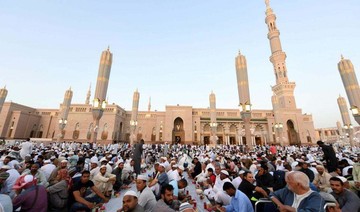MAKKAH: Makkah is famous for being a vibrant city throughout the year. Its long Umrah season, followed by the Hajj season, makes it a rich place visited by all nationalities from around the world. Makkah conforms to its culture, identity and profound heritage, especially during the holy month of Ramadan.
If you want to experience the aesthetics of Ramadan, Makkah is a Saudi city that’s wonderfully diverse. Citizens of different races were brought together by their love for Makkah, which they have chosen as a residence. This has characterized its identity and satisfied its customs and social patterns, making it unique among Saudi areas and cities.
The Mayor of Rea Zakher neighborhood, Fahad Al-Harbi, observes many traditions and historical features in Makkah, some of which have died out while others are still ongoing. Al-Harbi speaks of old neighborhoods that surrounded the Makkan sanctuary, and how they contributed to the culture of sharing and cooperating and laid friendliness in a small geographical area, linking districts and population centers of different races and spectrums.
Al-Harbi says Makkah witnesses an increased activity during Ramadan, one of the great occasions that reflect the cultures of this city’s citizens and how they create their own happiness.
The work in ful, Sobia, Arabic sweets and other shops increases and their owners are friendly with people. All owners of specific food sell their products with pleasure and ease. They sing beautiful tunes they inherited while selling balilah, fried dumplings and soup.
Al-Harbi also tells about districts in Makkah that become crowded every year owing to sports events and witness the residents of one neighborhood bringing lights and drawing the lines of football and volleyball playgrounds. Tournaments are also held during Ramadan where the neighborhoods’ mayors give away trophies in the final games.
“The citizens of many neighborhoods near the sanctuary, such as Al-Shubaikha, Al-Gemmezah, Al-Tundobawi, Jarwal and others, compete to serve pilgrims during Ramadan. They give them water during breakfast, guide lost people and help the elderly to get to the sanctuary, and these are traditions the citizens of Makkah are proud of, while considering them their duties,” Al-Harbi added.
Businessman and engineer Amin Hafez noted that throughout the years, the royal neighborhood has maintained its cultural value which reflects the spiritual and heritage side of Makkah. In its districts, the citizens of Makkah meet pilgrims and get to know each other, establishing a great brotherhood and beautiful friendship.
Hafez said the royal neighborhood included models of Makkan houses, popular cafés, small shops, old cars that were used in the past and the Makkan heritage and architectural museum. All this diversity has made Ramadan nights in the city incomparable with any other cities: they are old neighborhoods that were linked to the Makkan sanctuary, some of which have faded away with the commitments of widening the Grand Mosque.
One elderly man from the Jarwal area near the Makkah sanctuary, Faleh Al-Moutaweh, told of many Ramadan traditions Makkah was renowned for but have died out. People have become busier with the widening of urbanism in Makkah.
In the past, the houses in Makkah during the holy month were painted on the inside and outside, welcoming Ramadan. Lights were used and sessions set in the streets near the houses where men spent their nights during Ramadan. The curtains, mattresses and cushions were cleaned, and two days before Ramadan, preparing red and white Sobia was a must.
Al-Moutaweh added that young men and women used to compete to serve pilgrims. They used to go to the Makkan sanctuary before the evening prayer, carrying Zamzam water and dates in beautiful pots. They would communicate with pilgrims in the languages they had learned and serve them yogurt and coffee for the whole holy month.
Experience the aesthetics of Ramadan in Makkah
Experience the aesthetics of Ramadan in Makkah
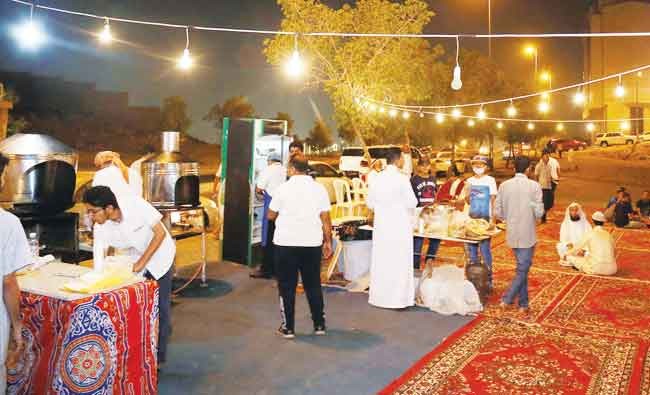
- The citizens of many neighborhoods near the sanctuary, such as Al-Shubaikha, Al-Gemmezah, Al-Tundobawi, Jarwal and others, compete to serve pilgrims during Ramadan
- The houses in Makkah during the holy month were painted on the inside and outside, welcoming Ramadan
Tima Abid’s ‘sea-spired’ collection opens first Red Sea Fashion Week

- Beadwork, satin used to mimic waves, gleaming glints on water
- Designer lauds support of Culture Ministry, Fashion Commission
RIYADH: Saudi Arabia designer Tima Abid opened the first Red Sea Fashion Week on Thursday with bridal wear inspired, or perhaps sea-spired, by the effervescent colors and tides of the ocean.
Backdropped by the glistening and clear turquoise waters of the St. Regis Red Sea Resort on the developing Ummahat Al-Sheikh island, Abid showcased luxurious, elegant and intricately-designed evening wear.

The Jeddah-born haute couture designer told Arab News: “When I was told that I would inaugurate Red Sea (Fashion) Week at the St. Regis and by the sea, it was a beautiful idea but very challenging. I was inspired for this collection by the Red Sea and its shades of sand. I used pearls, fishnets, and elements derived from the sea like the waves. I really aimed for couture to align with the mood that we’re in.”
Abid incorporated sheer chiffon, micro ruffles, and malleable fabrics to mimic an underwater experience.

Embroidered white gowns incorporating delicate beadwork and sequins on sumptuous fabrics such as elevated fishnet and satin were subtly nods to the softness of waves and prominence of fishing culture on the coast.
But the intricate and sharp designs also suggested the strength and sureness of crashing waves. As air does for sea, the silky silhouettes drifted in the wind, creating an ocean swell-like appearance. Speckled in jewels, the pieces resembled the gleaming glints on water.

Cream and beige looks also made it out to the dock-turned-runway, featuring chic feathered accents and unconventional fabrics that mimicked the Kingdom’s coral reefs. Bejeweled gloves, capes, veils, and draping fringed neck pieces married traditional and contemporary bridal wear while also taking inspiration from the ocean’s sea creatures.

Several well-known guests, which included TV presenter Lojain Omran and actress Mila Al-Zahrani, were all front row for the latest collection from Abid — whose meticulous attention to detail has birthed creations that incorporate deep sentiment and luxurious elegance for nearly two decades.
“I can’t thank the Ministry of Culture and the Fashion Commission enough for this opportunity and this trust. This inauguration is truly historic for me,” Abid said.
Saudi pop star Mishaal Tamer feels ‘honored and grateful’ ahead of sold-out London gig

- Singer tells Arab News his fans in the city have a special place in his heart but he owes his success to people all over the world who have embraced his music
- He says his debut album, “Home is Changing,” out in October, is a tribute to the changes and reforms that have swept through the Kingdom in recent years
LONDON: Saudi singer Mishaal Tamer said he feels honored to be performing his first headline show outside Saudi Arabia in London and is grateful to his fans there for their support.
Speaking to Arab News ahead of his sold-out gig on Friday at Camden Assembly, a live music venue and nightclub in Chalk Farm, Tamer said his fans in London will always have a special place in his heart.
“The people attending the show in London have been with me from before the starting line and I really appreciate that,” he said of the 220 people who will attend the event. “I will love those people forever and they will be in my heart forever.”
Tamer also thanked his fans in Saudi Arabia and elsewhere in the world, saying he owes his success as an independent artist to them.
“The kids that are back home and the ones abroad that have found me have been supporting me,” he said. “This would be impossible without them. I am grateful to the fans for listening to the music and sharing it.
He told how he was approached by two fans in a restaurant after arriving in the UK, which helped him realize how his profile was growing.
“One of them was Saudi, the other wasn’t,” Tamer said. “When I looked at that, it made me realize that not only was this bigger than I expected for me, as an artist, but that what we’re doing is bigger than me.”
His debut album, “Home is Changing,” is due for release in October and he said it is a tribute to the changes and reforms that swept through the Kingdom in recent years.
“There are so many opportunities that keep popping up, so many cool new things,” he added. “People have the freedom and creativity to make the world around them and the environment around them, to shape it into what they see in their heads.
“It feels almost like every other country is decaying whereas the Kingdom is growing and that feeling makes me proud.”
The evolution of Saudi Arabia “sets an example of always being hopeful for the future and having a positive attitude,” Tamer said. “And I think the optimism that we have right now in the Kingdom is a beautiful thing.”
Saudi filmmaker Abdulrahman Sandokji’s ‘Underground’ discusses the Kingdom’s music scene

- ‘Unfolding the unseen is my thing,’ says Abdulrahman Sandokji
DUBAI: “In film school, they tell you that your first film should be a documentary — train in a simpler form, then go to fiction,” says Saudi filmmaker Abdulrahman Sandokji. “So, naturally, I started with documentaries. But I got hooked.”
Over 15 years later, Sandokji still hasn’t moved on to fiction. Not that that’s an issue for him. His documentaries — produced by the company he founded, Basar Media — have proven immensely satisfying.
“A fiction film can take one or two years to shoot. I have no patience with waiting days and days to shoot one scene. I want things faster and more surprising,” he tells Arab News.

“And (documentaries) are honest. You’re talking about real stories. Unfolding the unseen is my thing, you know? I want to go into these deep places and show them to people,” he continues. “It’s a way to understand people, to really see people. To pick a flower from lots of beautiful gardens and plant them in your own garden. It’s more of a journey of discovery for me, you know? That’s what I love about documentaries.”
Sandokji’s breakthrough came with his 2014 film “Phosphine,” which he describes as a “Michael-Moore style” investigative documentary. It explored how the titular chemical — a potentially deadly respiratory poison — had been used (out of ignorance rather than malice) in homes to kill cockroaches, rats and other pests. While the actual occupants had been told to leave their apartments for five or six days, their neighbors were not, and the odorless gas killed them.
Sandokji put his documentary up on YouTube. It got 5 million views in five days, he says, adding that, at the time, he and his colleagues were delighted if they got 100,000 views on any of their videos, because they “weren’t funny — they weren’t comedies.” But “Phosphine” ended up making a difference to society, as well as to Sandokji’s career.
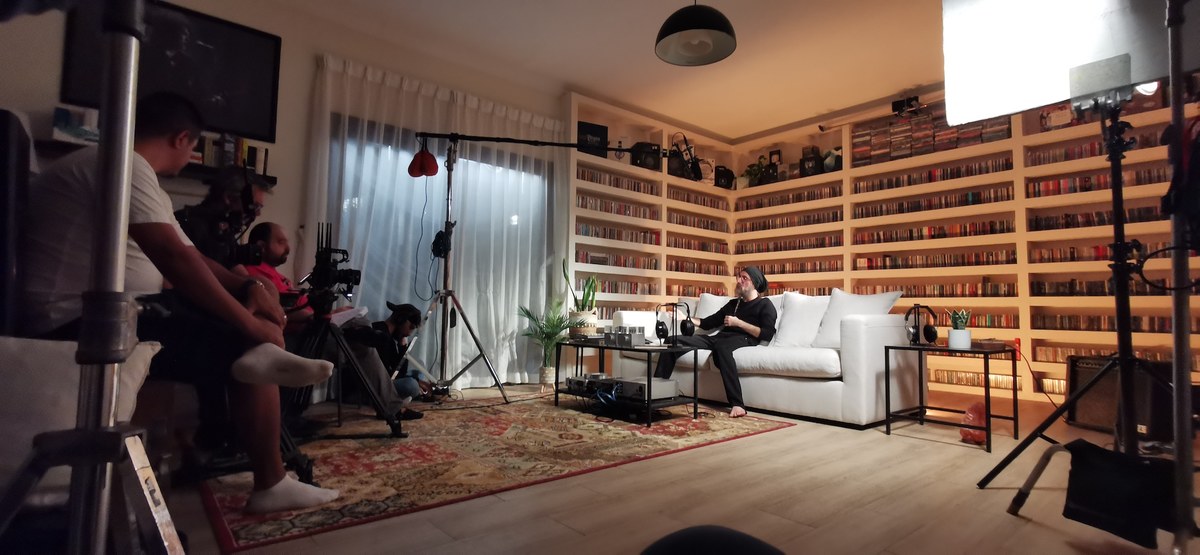
“We were on TV shows and talk shows — we were overwhelmed. Lots of social movement happened and governmental sectors held very urgent meetings about this substance. The Ministry of Health set up a hotline about it,” he says. “That was when I thought, ‘OK. Maybe this is your thing. Being a voice for those who want their voices to be heard.’”
Unlike “Phosphine,” Sandokji’s latest doc, “Underground,” is not a “tragic story.” But, once again, it was a “journey of discovery” for him — one that delves into the Kingdom’s burgeoning alternative music scene.
The idea — as for many of his films — was not Sandokji’s own. “When I analyze myself, I’m more of a person who receives an idea and then gets to enlarge it,” he says. “When I generate an idea myself, people go, ‘Mmm. No.’” He laughs. “They’ll go, ‘How about this idea instead?’ I’m like the gas — just throw the spark on me and I’ll explode, you know?”
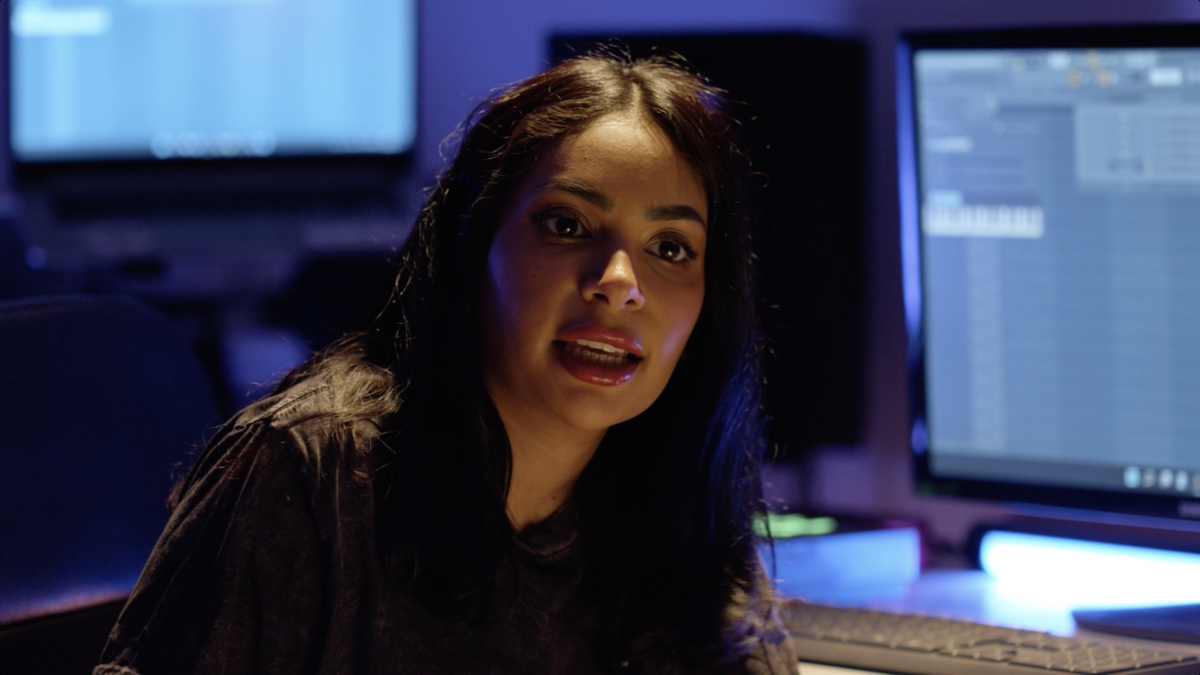
The “spark” for “Underground” came from a friend, Tamer Farhan. “He’s passionate about underground music. He knows all these artists,” Sandokji says. “And he opened the window to me and said ‘Come and have a look.’”
What Sandokji found was a wealth of talent and experience that has largely gone unnoticed in Saudi Arabia — understandably, given that until recently live music was largely outlawed in the Kingdom, and music that wasn’t commercial Khaleeji pop or classical Arabic fare was frowned upon.
“These people are good people,” says Sandokji. “Over the years people talked about the music underground as this place with drugs and all this prohibited stuff. But no. They are nice. They have feelings. They love their music and they’re passionate and they’re kind.”
That passion shines through in “Underground,” whether from veterans such as metal band Wasted Land’s frontman Emad Mujallid or relative newcomers such as DJ Cosmicat (Nouf Sufyani) and Salma Murad. All the artists involved are given the opportunity to discuss their craft and love for music in depth, and to play some of their music live.
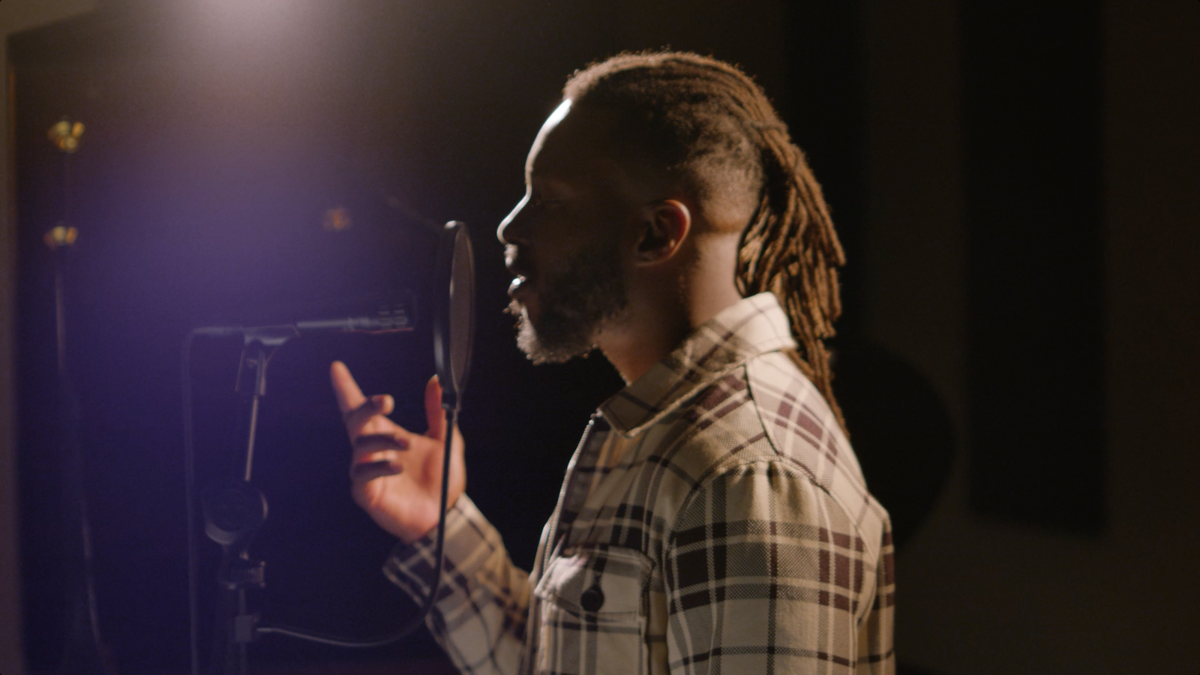
“(The songs) are not recorded and synced,” Sandokji says. “I wanted to show the audience how talented they are.”
So far, that audience is whoever attended the premiere on the opening night of the Saudi Film Festival on May 2 — another landmark for Sandokji, he explains. “Usually they choose fiction films — good fiction films — for the opening. I was always watching them thinking ‘When am I going to make a movie that could be screened in the opening? I’m a documentary maker, nobody would give me that chance.’ But it happened.”
And he believes “Underground” has the potential to grab international attention. It’s already been submitted for consideration at several large festivals, but the main aim since he started shooting it in 2022, Sandokji happily admits, has been to get the film on Netflix. There are also discussions underway about turning it into a TV series.
“It’s something people will want to know more about, I think,” he says, before citing the words the movie concludes with, when Murad is discussing what music means to her: “It’s powerful. It’s beautiful.”
“When Salma said that, I had goosebumps,” Sandokji says. “I thought, ‘Yes! These are the words the movie has to end with.’ Music is powerful; it can make you very strong, it can make you very weak… it’s magical.”
El Seed launches Tunisian olive oil brand Tacapae with artworks for bottles

DUBAI: French-Tunisian artist El Seed’s take on Arabic calligraphy (sometimes referred to as ‘calligraffiti’) has embellished favelas in Brazil, marginalized buildings in Cairo, and the Saudi desert. He is known for working with local communities to share messages of human connection, based on quotes from influential writers and philosophers.
In a departure from his usual large-scale artworks, the artist recently launched his most intimate endeavor to date. The project is called “Tacapae” and consists of olive oil-filled bottles decorated with El Seed’s swirling calligraphy. The name of the brand is inspired by the ancient Greek name of the artist’s hometown, Gabes, in southern Tunisia, from where the olive oil is sourced.

“I didn’t want to call it ‘El Seed Olive Oil’ because I don’t link the oil to myself,” El Seed tells Arab News at his Dubai studio in Alserkal Avenue. “I’m the founder, but the goal is to have a bottle designed by other artists every year. It’s a kind of partnership.”
El Seed explains that his cousin informed him of a plot of land for sale in Gabes. “And it happened that the olive trees of this land were planted by my great-grandfather,” he says.
El Seed purchased the land and its trees now provide the oil for Tacapae. A total of 31 bottles (a tribute to the land’s original 31 trees) were personally hand-finished by the artist himself.

The most powerful aspect of the ceramic, handmade bottles is the quote El Seed used. Translated into Arabic from a quote by 20th-century US novelist John Dos Passos, it reads: “You can snatch a man from his country but not the country from a man’s heart.”
Those words have resonated with El Seed his whole life. “Nobody can take away from you all the memories that you carry for a particular place,” he says. “I grew up in France, I live in the US and Canada and I spend some time in the Middle East, but my main focus is in Tunisia. I carry it with me.”
Where We Are Going Today: Armin restaurant in Riyadh

- Armenian cuisine is a blend of Middle Eastern, Mediterranean and Eastern European influences
RIYADH: Riyadh’s popular Armenian restaurant, Armin, takes visitors on a journey of authentic flavors with its heartwarming, aromatic and herby dishes.
Armenian cuisine is a blend of Middle Eastern, Mediterranean and Eastern European influences with ingredients such as rice, lamb and sumac.
Armin hits the taste nail on the head with a selection of Middle Eastern dishes featuring chicken and lamb kebabs, tabouleh, fattoush, vine leaves, and a popular eggplant dip, muttabal.
The menu provides guests with options aplenty, with vegetarian and omnivorous diners catered for, making it an ideal spot for dining out.
Upon arrival, guests are spoiled with freshly baked pita bread, perfect to plunge into their dipping of choice.
The best appetizer on the menu is the hummus with meat and topped off with crispy pine nuts, making a perfect combination of nutty flavors.
A must-have side dish is the spicy potato, cooked to perfection with a kick of spice and a touch of garlic and coriander.
The star main course is the shish barak, a traditional Armenian dish consisting of dumplings made with a thin dough wrapper and filled with flavorful beef or lamb with onions and a mix of spices.
Shish barak is boiled, unlike Chinese or Japanese dumplings, which are usually pan fried or steamed.
The only downside of the visit is cost — Armin’s prices are on the high side. But given its customer service and delicious food, it is a price worth paying. Although many dishes on Armin’s menu can be found in Middle Eastern restaurants for a fraction of the price, the quality of the ingredients here is unmatched.




